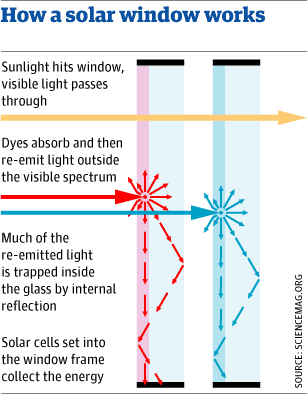Batteries are good at storing energy for a long period of time, and transmitting it slowly.
Capacitors are good at transmitting energy quickly, and without losing performance over time.
Efforts have been made, in the renewables industry, to utilise the best of both, to store large amounts of energy, while still being able to use the energy when needed.
The EFC (electro-chemical flow capacitor) uses a slurry of carbon particles in electrolyte to store electrical energy - the particles are charged, and pumped into another tank, where they wait to dispel their charge on return, when needed.
"The main advantage of the EFC is that its design allows it to be constructed on a scale large enough to store large amounts of energy, while also allowing for rapid disbursal of the energy when the demand dictates it."
http://phys.org/news/2012-07-renewable-viable-technology-grid-level-electrical.html
'Dutch student offers new insight into power-generating windows'
By placing a thin layer of luminescent material across windows, and a rim of solar cells around the edge of the window, the light energy is guided to the cells for power generation.
"Luminescent solar concentrators are capable of generating dozens of watts per square metre."
"A transparent film produces a maximum of 20 watts per square metre, which is an efficiency of 2%. To power your computer you would need a window measuring 4 square metres."
"A foil that mainly absorbs the blue, violet and green light particles will give the window a red colour. Another option is to use a foil that absorbs all the colours of the solar spectrum equally. This would give the window a grey tint. Both the red and the grey film have an efficiency of 9%, which is comparable to the efficiency of flexible solar cells."

http://phys.org/news/2012-07-dutch-student-insights-power-generating-windows.html
'New chip captures power from multiple sources: light, heat and vibrations'
A low-power energy harvester has been designed, that can utilise solar, vibrational, and thermal energy sources. It uses capacitors to integrate the power, however, because they fade in and out, independently, and so it's difficult to maintain a steady power output.
"circuits to harvest thermal differences typically produce only 0.02 to 0.15 volts, while low-power photovoltaic cells can generate 0.2 to 0.7 volts and vibration-harvesting systems can produce up to 5 volts. Coordinating these disparate sources of energy in real time to produce a constant output is a tricky process."
http://phys.org/news/2012-07-chip-captures-power-multiple-sources.html
[video] A Ukrainian team has won the Imagine Cup - a prize issued by Microsoft for using Microsoft technology in ingenious ways.
They developed a sign-language-to-speech translator, which takes hand movements, and converts them into words, so that deaf people who can sign, but not communicate with hearing people, can do so.
The gloves will cost $50, at first, and be available to anyone who can plug them into their phone. The devices predecessors were slow, insensitive, and hundreds of times more expensive.
http://phys.org/news/2012-07-ukraine-team-cup-gloves-language.html
Iris scanning systems have a decay rate, it seems. In some cases, irises no longer matched the images on record, after just a few years.
This means the recorded iris images will have to be updated every few years, to avoid false negative results.
Worth it for rich business commuters, maybe. But for holidaymakers? Too much hassle - too little genuine security.
http://phys.org/news/2012-07-iris-recognition.html
[video] A Salt Lake City company has designed a system of solar panels, that can be integrated into clothing, and can produce enough power to charge a mobile phone in a few hours.

http://phys.org/news/2012-07-powercloth-1g-utah-ultra-light-flexible.html
Gel mixture lets you hide a secret message in goo

http://www.newscientist.com/blogs/onepercent/2012/07/hybrid-gels-with-a-hidden-mess.html
Lizard bot shows how to scamper over the sand
http://www.newscientist.com/article/mg21528735.500-lizard-bot-shows-how-to-scamper-over-the-sand.html
No comments:
Post a Comment